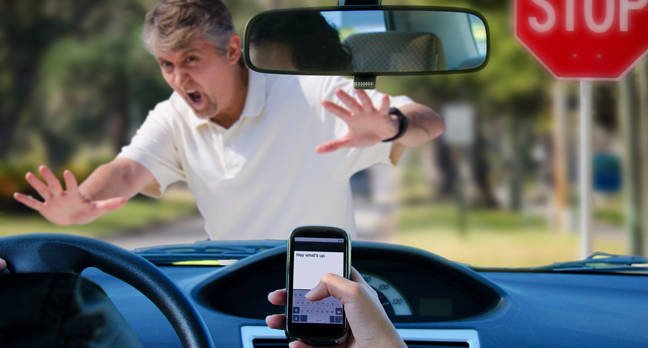Something for the Weekend? Er… a lamppost, some clouds and… whoah, another car! Screeeeeee.
Instead of concentrating on the road ahead, I got distracted by the non-stop nagging. I am alone in the car, mind, and the radio is turned off. It’s my smartphone that’s doing all the talking.
Some acquaintances convinced me to give this Doze route-finding app a second try, and the thing won’t shut up. Every two seconds, it’s ordering me to take deep breaths or relax for the next 20 miles or name three things I can observe outside the car.
It would do better to remind me to watch out for other traffic; mind my speed; check the mirrors regularly; keep my eyes on the road; my hands upon the wheel; the future’s uncertain and the end is always near; that sort of thing.
What I don’t need is constant reminders on the benefits of respiration, or playing I-spy while careering about in a freewheeling, one-tonne clump of glass, metal, plastic and flammable liquid.
I suspect it has it in for me, and for anyone unlucky to be on my route too. This is shortly confirmed by the app as it correctly identifies that the street ahead is one way only, showing chunky single-direction arrows on the map, but with the angle of these arrows a number of degrees out of kilter – 180 to be exact. In other words, precisely the wrong direction. Nice.
The app’s only saving grace is that it is not as terrible as the built-in sat-nav that came with the car. Mind you, that’s not saying much. My car’s sat-nav is about as reliable as asking a passing drunk for directions. I could be driving out of Cairo towards the Great Pyramids of Giza and the “Interesting Places Nearby” section of the sat-nav would still insist my best option was Blackpool Tower.
Still, the people who design these driving assistance technologies are much smarter than me. And the last thing I want is to become one of those nutty conspiracy theorists who disagree with clever people without boasting the necessary university qualifications to do so. So I take the turn as directed by Doze and hurtle the wrong way down the one-way street, while making sure to take deep breaths and name three types of pedestrian as they leap out of my path.
Oh go on, let’s take a detour by the hospital. I hear it’s Euthanasia Day, Mr Frankenstein.
I trust the same eggheads are working on the many assistive technologies being built into the next wave of self-crashing cars. I consider myself a fairly experienced driver but not fully experienced – I have never pranged another car – but I can see the world’s finest private vehicle technologists are hard at work trying to put this right.
Browsing through some ghastly scandal rag the other week, I read that Tesla was expected shortly to send an over-the-air update to 50,000 of its cars in the US to disable a software feature officially called Full Self-Driving. Apparently it had been designed to slow down at a Stop sign rather than come to a full halt, allowing the nominated driver to look both ways as the vehicle creeps towards the junction before choosing to lurch across it.
America’s traffic regulators didn’t like this. Here in France, failing to come to even a momentary halt at a Stop sign risks incurring instant financial and licence penalties. But come on, everyone does it – so Full Self-Driving does it too.
Up to that point, I had assumed assistive driving technologies were designed to take over the boring but important actions that distract the driver. Staying in lane, minding the speed limit, giving proximity warnings when objects are in the blind spot and that sort of thing. Surely, I imagined, they’re supposed to make us better drivers.
How naive. Now I realise they are simply designed to copycat the way the average motorist drives already. By failing to stop when the sign reads STOP, Full Self-Driving is essentially a shit-driving emulator.
To be fair, Tesla advises: “The currently enabled Autopilot and Full Self-Driving features require active driver supervision and do not make the vehicle autonomous.” In other words, a car with Full Self-Driving does not mean the car is fully self-driving. How foolish of me, of course it doesn’t! What was I thinking?
Fundamentally, assistive driving tech is all about making the driver (or in the case of driverless vehicles, passengers) happy and carefree. It has stuff- all to do with road safety.
Take this summary of a development project reported in IEEE Robotics and Automation Letters, for example. It starts out as an investigation on what motorists do when they see a pedestrian about to cross the road, with the aim to teach self-driving cars how to conduct themselves in the same scenario. A VR experience – a metaverse, I think they call it now – was duly built to analyse how the metamotorist and the metapedestrian interact.
What they found was that good drivers in built-up areas have learnt to recognise a pedestrian’s body language and facial tics that suggest they are about to step into the road. In turn, savvy pedestrians look to see whether an approaching driver is waving them across and try to judge whether the car is slowing down to allow them to do so safely. Programming such expressive behaviour into a smart-thinking driverless car is a challenge.
One solution, they decided, would be for self-driving cars to send signals to pedestrians via their augmented reality wearables to tell them whether it is OK to cross the road or not. Or in other words, a system whereby the driverless car communicates to pedestrians to stay the fuck out of the way because slowing down will lessen the comfort of my passengers.
It’s endemic throughout the assistive vehicle tech industry: the motorised vehicle always takes precedence over the pedestrian (on foot, on crutches, in wheelchairs or whatever), despite the fact that pedestrianism is the natural state for most of us. Until there is a fundamental conceptual shift away from such thinking, we are doomed to have shit driving deliberately programmed into all forms of automated transport in the future.
If only the industry could concentrate on safety and efficiency rather than driver comfort, every car manufactured today would already have the single most useful feature that any private vehicle could offer, ever: fully automated reverse parking.
Then again, if I left it up to Doze, it would spin out donuts and reverse the car onto the pavement at right-angles to the kerb. Useless and even dangerous, perhaps, but all done, no doubt, in perfect comfort while I’m deep-breathing at the wheel.
Some clouds… a broken lamppost… ah yes, and an approaching policeman.

Alistair Dabbs is a freelance technology tart, juggling tech journalism, training and digital publishing. More at Autosave is for Wimps and @alidabbs.



